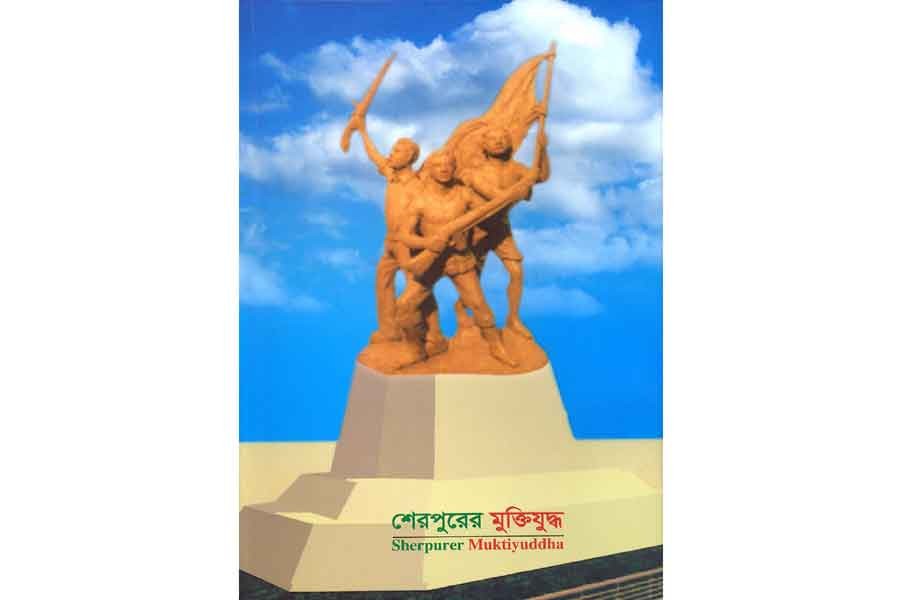The Liberation War of 1971 is the most glorious chapter in the national history of Bangladesh. Every nook and cranny of the country still resonates with the heroic and courageous stories of the then occupied country's Freedom Fighters, who bravely fought against the Pakistani occupation forces to present us with an independent Bangladesh. But very few of us, the new generation in particular, could go through authentic accounts of the Liberation War, as not many fact-based books on the war have been published so far. Now here comes a book-'Sherpurer Muktijudhho' (Battle for Liberating Sherpur) -- which offers glimpses of that time when the valiant sons of Sherpur stood against the ruthless and marauding Pakistan army.
The 349-page book, edited by renowned Freedom Fighter AA Jafar Iqbal who hails from Sherpur, then a sub-division, now district, highlights the war heroes and their valour during the Liberation War in that region, an area bordering India. It was under Sector-11. A renowned Freedom Fighter in the sector was Major Taher, the sector commander. He led five big operations, out of seven, at Kamalpur, a frontier village where an EPR (East Pakistan Rifles) Border Outpost (BOP) was located. EPR was a border protection force in the then East Pakistan. The village, which was strategically important for the Freedom Fighters, saw more and bigger battles than in any other places in Bangladesh.
A prominent feature of this book is the list of almost all Freedom Fighters and others along with their photographs who immensely contributed to freeing the region from the clutches of the Pakistani occupation forces.
The book's presentation of the incidents of operations by the Freedom Fighters against their enemies is unique; the descriptions is so vivid and real that a reader would feel like being back to those days and to the very places of the battles. The book is highly engrossing as it invokes a sense of national pride and enhances our respect for those who laid down their lives for freedom in the 1971 Liberation War.
Prior to the start of the Liberation War, the public representatives and political leadership in Sherpur, along with students, came forward to mobilise public support and organise the war soon after the country's supreme leader Bangabandhu Sheikh Mujibur Rahman made the declaration of independence. Earlier, Chhatra Sangarm Parishad and Sarbadaliya Sangram Parishad were formed as part of the preparations for the war. Members of the East Pakistan Rifles (EPR) imparted training to Freedom Fighters at the very beginning and helped forge resistance against the enemies.
On April 27 in 1971, the Pakistan army invaded the Sherpur town firing indiscriminately and killed a number of people. Later, they formed their collaborators --- Razakar forces and Al-Badr forces with the help of the pro-Pakistan political parties, to create a reign of terror in the region.
The brutalities carried out by the Pakistan occupation army in collaboration with Razakars cannot be described in words, but the Sohagpalli, a village, still stands witness to its savagery. The village gradually became known as Bidhobapalli (Widows' Village) as almost all married women in the area lost their husbands to the cruelty of the marauding army in a single day. On July 25, 1971, the occupation army with the help of Razakars suddenly attacked the village and started firing on unarmed innocent people frenziedly. Nearly 200 people were killed in a six-hour attack.
The book gives details of many operations by the Freedom Fighters against the brutal army and their collaborators. These operations were carried out in various places, including Nakshi, Bhayadanga and Jhinaigati. The Freedom Fighters also attacked Sherpur, Nakla, Sribordi and Nalitabari police stations. Those who led these operations and those who were martyred in these operations figured prominently in the book.
The Freedom Fighters finally declared Shrepur a free zone on December 7, 1971 and hoisted the flag of independent Bangladesh.
The book prominently focuses on the history of the Liberation War, how it unfolded and who were the key contributors. It has tried to portray all the events authentically.
In this regard it can claim a remarkable place in the country's Liberation War publications. A team of journalists collected all the information for the book. They visited the places where the operations took place and talked to local people and the persons directly involved with the war. Besides, information and data collected from reference books and provided by different organisations and individuals have enriched the publication.
The book is a treasure-trove of information about the 1971 Liberation War. It will act as a guideline for those who want to carry out researches on the country's great war of liberation.
e-mail:[email protected]


